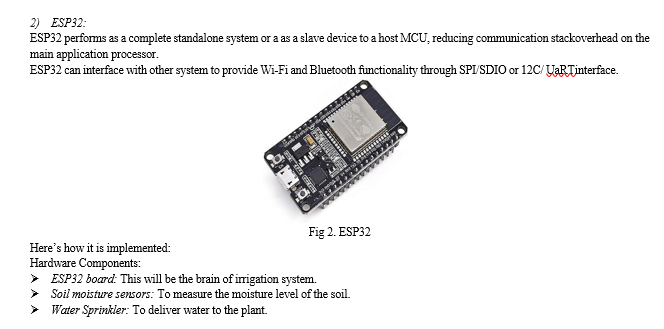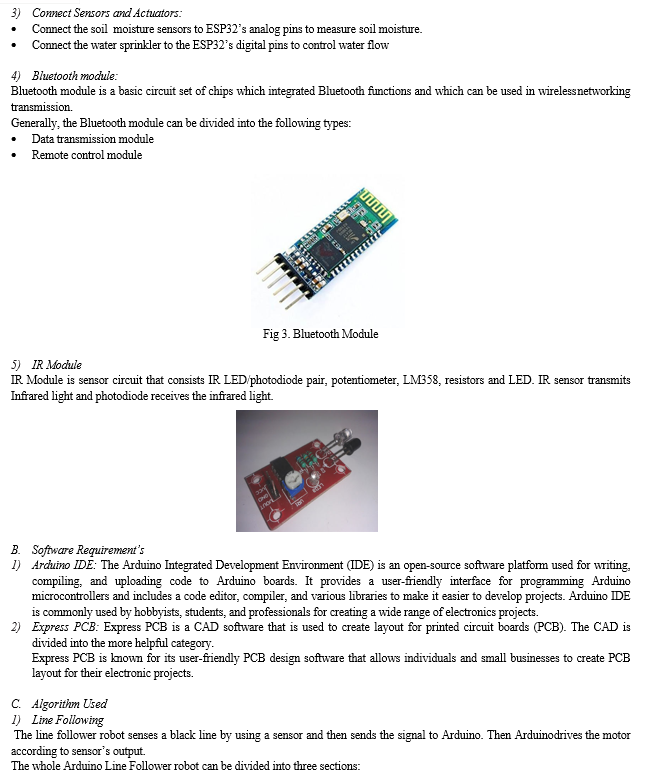Ijraset Journal For Research in Applied Science and Engineering Technology
- Home / Ijraset
- On This Page
- Abstract
- Introduction
- Conclusion
- References
- Copyright
SMART Irrigation Robot
Authors: Prof. Hiranwale. S.B, Ghodke Shrushti, Sapre Neha, Jadhav Shital, Godase Smita
DOI Link: https://doi.org/10.22214/ijraset.2024.60754
Certificate: View Certificate
Abstract
Smart irrigation robots are solutions for today\'s agriculture that solve water management, work efficiency and crop quality problems. This autonomous robotic system combines advanced technology, sensors, artificial intelligence and precision robots to revolutionize the irrigation process. This content highlights the key features and advantages of smart water users. The robot uses a network of soil moisture sensors and weather data to make real-time, data-driven decisions about when and how much to harvest. Using smart algorithms, irrigation strategies can be tailored to specific crop types and growth stages to ensure efficient use. Operating costs. It also promotes sustainability and environmental protection by reducing water waste by providing the required amount of water where and when it is needed.
Introduction
I. INTRODUCTION
Smart irrigation robots are a new solution for inadequate watering of the land, garden or landscape. Robotic processes combine technologies such as sensors, artificial intelligence and automation to optimize x processes. By monitoring the environment such as humidity, weather and the needs of plants, the smart irrigation robot can determine data for spraying crops or plants where and when they need, thus saving water and increasing yields. These robots are designed to reduce labor, save water and ensure the sustainability of agriculture and horticulture. Smart irrigation robot is a multifunctional, autonomous machine that intelligently controls the agricultural irrigation process. Unlike traditional plumbing that relies on schedules or manual maintenance, this robotic system uses the power of advanced sensors, connections and algorithms to deliver controlled water.
The main roles and products of smart water users are:
- Measurement technology: The robot is equipped with many sensors, including soil moisture sensors, water sensors and visual cameras. Sensors constantly monitor the surrounding environment and humidity.
- Autonomous Navigation: The robot's movement is guaranteed by autonomous navigation, which allows it to move anywhere without human intervention. It can adjust its path according to changing environments and problems.
- Efficient use of water: Smart water users can manage water to avoid excess water and water wastage. This not only saves water but also prevents water from damaging crops.
- Remote monitoring: Irrigation robots can be monitored and controlled remotely via mobile applications or web interfaces; Thus, adjustments can be made according to real-time data and weather conditions.
Smart irrigation robots not only improve the quality of water, they also have the concept of precision agriculture. Farmers can manage and monitor the smart remote control through a simple interface, making it easy to make irrigation plans and settings. This not only reduces crop yields, but also reduces the ecological footprint caused by excessive water use. In this guide we only scratch the surface of what smart irrigation robots represent. Symbolizing the combination of advanced technology and environmental responsibility, this project has a bright future with the potential to create a successful, environmentally friendly and agricultural landscape where precision agriculture and sustainable water management will flourish.
II. LITERATURE REVIEW
[1] proposed a method to integrate precision agriculture and smart grid technology. It is aimed to balance the consumption and production of agricultural lands and thus ensure energy supply security.
Collaboration and network support during peak hours[2]. However, to use this model, the energy and water used need to be reduced, making it very expensive and reducing its feasibility.
The work in [3] proposed a centralized smart irrigation system to manage multiple fields. Each farm has a data collection system connected to computers installed on the farm.
Communication occurs over the TCP/IP protocol on the Internet, which limits its use. In [4], a cloud-based smart irrigation control system using wireless sensor networks was proposed. Environmental parameters are collected by sensors and sent to the cloud for analysis. After the sensor data is measured, it is checked by the network partner cloud. The system also requires an internet connection.
The study in [5] also addresses energy and water waste problems in regions with limited water use by using water pipes in the context of IoT. The system collects environmental information and sends it online to farmers for easy decisions, which limits the system's ability to create space.
Operating costs are also high because they include energy and internet costs. The studies conducted in [6] also proposed a monitoring system. It records environmental parameters such as temperature, relative humidity and precipitation, as well as vegetation such as traffic and leaf moisture.
This is done using wireless devices in the area. Statistics are sent to a central location where decisions are made. This control unit communicates with the actuator to start the pump at a certain time. The main difference between this system and the system mentioned in this article is that the control room of the latter has a decentralized structure. Each unit is independent. In [7], it was proposed to use smartphones to change and monitor water flow to solve the need for automatic water management near the roots of vegetables. Humidity, temperature and humidity data are collected and sent to the smartphone where the user can make decisions. The user remotely starts the irrigation system by sending commands to the irrigation controller.
However, it cannot be used in this way as it interferes with the deployment of manpower. This increases operating costs, especially for large smart businesses. It also requires possession of a smartphone and the ability to use it; This poses a challenge for developing countries. Another smart method is proposed in [8], which has a climate changes that will collect humidity data and send it to the central server via Xbee communication. It allows farmers to monitor soil moisture through a user-friendly interface. This ensures good maintenance of the farm. But automatic irrigation is important because it reduces the operating costs of smart farms. This was not included in the decision.
A low-energy, cost-effective platform for irrigation is proposed in [9]. Its name is TinyOS. The operating system consists of three key layers that help improve smart water usage. These layers include management, information and communication. With this process, systems can be created to solve electricity and wastewater problems in water use.
III. PROPOSED SYSTEM
A smart irrigation robot is for an efficient agricultural management system that enables farmers to tackle the challenges they face. IoT has many applications, addressing key issues such as soil moisture detection, water conservation management, crop growth monitoring, etc. This project enables better and smarter irrigation through temperature, humidity and other sensors networked to communicate with the user. . For farmers and growers, the Internet of Things has provided highly productive ways to cultivate land with the rich use of cheap, easy-to-install sensors and the insightful data they offer.
A smart irrigation robot consists of a water sprinkler and an integrated network of sensors. To enable communication, the sprinkler is controlled by a microcontroller via a servo motor. The microcontroller sets the angle between which the servo motor should rotate, enabling the sprinkler to irrigate only within those angles.
A. ardware Component’s Used
- Microcontroller
- ESP32
- Four DC motor
- Bluetooth module
- Battery 12v
- Water pump
- Sprinkler
- Water tank
- IR Module
1) Microcontroller: A Microcontroller is a key component in SMART irrigation robot as it plays a central role in controlling and automating the irrigation process.

Here’s how a microcontroller is used in such system:
- Sensor Integration: The microcontroller is connected to various sensors such as soil moisture sensors, temperature sensors, humidity sensors, and sometimes even weather sensors. These sensors collect data about the environment, soil conditions, and weather.
- Data Processing: The microcontroller processes the data from the sensors to make decision about when and how much to water the plants. It can analyze the soil moisture levels, weather forecasts, and other relevant data to determine the optimal irrigation schedule.
- Wireless Communication: In some cases, microcontroller in SMART irrigation system are equipped with wireless communication modules like Wi-Fi or Bluetooth. This allows remote monitoring and control of the irrigation system through a smartphone app or a web interface.
- Automation and Optimization: The microcontroller can run algorithms that automate the irrigation process and optimize it for water conservation and plant health. It can adjust watering schedules and duration dynamically to adapt to changing environmental conditions.
- User Interface: Some SMART irrigation systems have a user interface, often a touchscreen or a mobile app, where users can input settings and preferences. The microcontroller processes user inputs and adjusts the irrigation parameters accordingly.
A microcontroller in a SMART irrigation robot serves as the brain of the system, collecting and processing data from various sensors and controlling the irrigation process to ensure efficient and effective watering while conserving resources.




|
Input |
Output |
Movement Of Robot |
||||
|
Left Sensor |
Right Sensor |
Left Motor |
Right Motor |
|||
|
LS |
RS |
LM1 |
LM2 |
RM1 |
RM2 |
|
|
0 |
0 |
0 |
0 |
0 |
0 |
STOP |
|
0 |
1 |
1 |
0 |
0 |
0 |
TURN RIGHT |
|
1 |
0 |
0 |
0 |
1 |
0 |
TURN LEFT |
|
1 |
1 |
1 |
0 |
1 |
0 |
FORWARD |
There are four conditions in this line following robot that we read by using Arduino. We have used two sensors namely the left sensor and the right sensor.
Conclusion
This project presents the design of an IoT based SMART automatic Irrigation robot. The proposed system can reduce the efforts of farmers and provides high yield. It also conserves water for irrigation by locating the sensors. This work have shown the plants can still sustain at low moisture level when the temperature is moderate. Analyzing more than one parameter has made this system an efficient one for managing the field.
References
[1] S. Odara, Z.Khan, and T.S. Ustun, “Integration of Precision Agriculture and Development,” IEEE Int. Conf.Technol. Innov. ICT Agric. Rural Dev (TIAR), Chennai, India July 10-12, pp. 1-28, 2015 [2] S. Odara, Z.Khan, and T.S. Ustun, “Optimizing Energy Use of Smart Farms with Smart grid Integration.” 3rd IEEE Int. Renew. Sustain. Energy Conf. (IRSEC), Marrakesh, Marocco, 8-10 December, 2015 [3] R. Zaier, S. Zekri, H. Jayasuriya, A. Teirab, N. Hamza, and H. AI-busaidi, “Design and Implementation of Smart Irrigation System for Groundwater Use at Farm Scale,” 7th int. conf. Model. Identif. Control (ICMIC), Sousse, Tunis.December 18-20, no. Icmic, pp. 3-8, 2015 [4] N. Sales. “Wireless Sensor and Actuator System for Smart Irrigation on the Cloud,” Internet Things (WF-IoT),IEEE 2nd World Forum, Milan, Italy, December 14-16, pp. 693-698, 2015 [5] B. Khelifa, D. Amel, B. Amel, C. Mohamed, and B. Tarek, “Smart Irrigation on the cloud,” Internet of Things,”4th Int. Conf. Futur. Gener. Commun. Technol. (FGCT 2015), Luton, England, July 29-31, no. Fgc, pp. 1-6, 2015. [6] L.G. Paucar, A.R. Diaz, F Viani, F. Robol, A. Polo, and A. Massa, “Decision Support for Smart Irrigation By Means Of Wireless Distributed Sensors,” Microw. Symp. (MMS), IEEE 15th Mediterr. Lecce, Italy Novemb. 30, pp. 5-8, 2015. [7] P. Alagupandi, R. Ramesh, and S. Gayathari, “Smart irrigation system for outdoor environment using smart phone and wireless sensors networks for smart farm,” ICWise Malaysia, 2014-2014 IEEE Conf. Wirel Sensors, Subang, Oct. 26-28, pp. 106-112, 2014. [8] A. Kumar, K. Kamal, M. O. Arshad, S. Mathavan, and T. Vandamala, “Smart irrigation using low-cost moisture sensors and XBee-based Communication,” Proc. 4th IEEE Glob. Humanit. Technol. Conf. GHTC 2014, San Jose, Carlifinia, Oct. 10-13, pp. 333-337, 2014. [9] P. Alagupandi, R. Ramesh, and S. Gayathri, “Smart irrigation system for outdoor environment using Tiny OS.” 2014 Int. Conf. Comput. Power, Energy, Inf. Commun. ICCPEIC 2014, Chennai, India, April 16-17, pp. 104-108, 2014.
Copyright
Copyright © 2024 Prof. Hiranwale. S.B, Ghodke Shrushti, Sapre Neha, Jadhav Shital, Godase Smita. This is an open access article distributed under the Creative Commons Attribution License, which permits unrestricted use, distribution, and reproduction in any medium, provided the original work is properly cited.

Download Paper
Paper Id : IJRASET60754
Publish Date : 2024-04-22
ISSN : 2321-9653
Publisher Name : IJRASET
DOI Link : Click Here
 Submit Paper Online
Submit Paper Online

